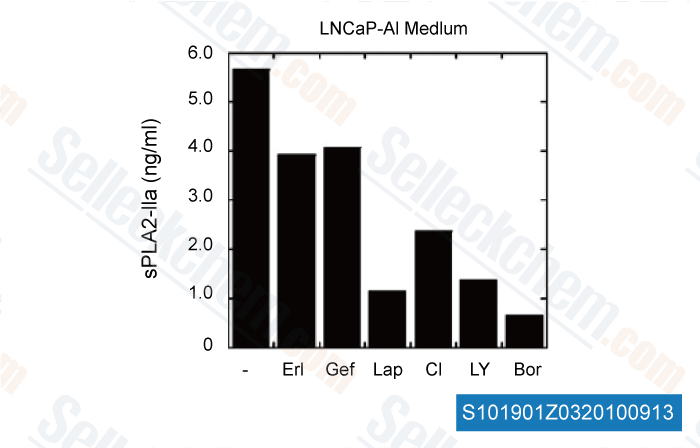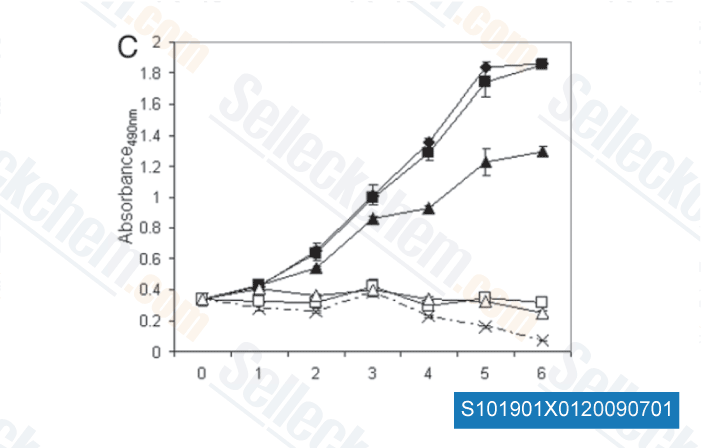|
Toll Free: (877) 796-6397 -- USA and Canada only -- |
Fax: +1-832-582-8590 Orders: +1-832-582-8158 |
Tech Support: +1-832-582-8158 Ext:3 Please provide your Order Number in the email. |
Technical Data
| Formula | C24H25ClFN5O3 |
|||
| Molecular Weight | 485.94 | CAS No. | 267243-28-7 | |
| Solubility (25°C)* | In vitro | Ethanol | 9 mg/mL (18.52 mM) | |
| DMSO | 2 mg/mL (4.11 mM) | |||
| Water | Insoluble | |||
|
* <1 mg/ml means slightly soluble or insoluble. * Please note that Selleck tests the solubility of all compounds in-house, and the actual solubility may differ slightly from published values. This is normal and is due to slight batch-to-batch variations. * Room temperature shipping (Stability testing shows this product can be shipped without any cooling measures.) |
||||
Preparing Stock Solutions
Biological Activity
| Description | Canertinib (CI-1033, PD183805) is a pan-ErbB inhibitor for EGFR and ErbB2 with IC50 of 1.5 nM and 9.0 nM, no activity to PDGFR, FGFR, InsR, PKC, or CDK1/2/4. Phase 3. | ||||
|---|---|---|---|---|---|
| Targets |
|
||||
| In vitro | CI-1033 shows excellent potency for irreversible inhibition of erbB2 autophosphorylation in MDA-MB 453 cells. CI-1033 also shows high permeability in Caco-2 cells and inhibits secretory transport of vinblastine, which indicates that CI-1033 is a likely inhibitor of the P-gp. [1] CI-1033 alone, significantly suppresses constitutively activated Akt and MAP kinase. In combination with gemcitabine, CI-1033 inhibits Akt and prevents increased levels of MAPK phosphorylation. CI-1033 stimulates p27 expression and p38 phosphorylation in MDA-MB-453 cells. [2] CI-1033 is highly specific to the erbB receptor family and not sensitive to PGFR, FGFR or IR even at 50 μM. CI-1033 shows high levels of inhibition in A431 cells expressing EGFR with IC50 of 7.4 nM. CI-1033 suppresses heregulin-stimulated tyrosine phosphorylation of erbB2, erbB3 and erbB4 with IC50 of 5, 14 and 10 nM, respectively. CI-1033 also inhibits expression of pp62c-fos in response to heregulin. [3] CI-1033 is predicted to modify Cys773 covalently within the ATP binding site of the HER2 kinase and enhances destruction of both mature and immature ErbB-2 molecules. [4] CI-1033 induces a significant decrease in measurable phosphorylation of tyrosine residues 845 and 1068 of EGFR, which are responsible for Src and Ras/MAPK signaling respectively. The corresponding residues of Her-2, tyrosine residues 877 and 1248 are dephosphorylated significantly by CI-1033 at a concentration of 3 μM or higher. CI could block EGFR internalization and increase the rate of apoptosis in primary osteosarcoma cells in a titratable fashion. [5] In addition, CI-1033 inhibits the proliferation of TT, TE2, TE6 and TE10 cells significantly at 0.1 nM. [6] | ||||
| In vivo | CI-1033 shows impressive activity against A431 xenografts in nude mice at 5 mg/kg of body weight. [1] CI-1033 (20 to 80 mg/kg/d) achieves a high degree of tumor regressions in H125 xenograft models. [3] Oral administration of CI-1033 causes a marked inhibition of growth in TT, TE6 and TE10 xenografts in nude mice, without animal death and <10% weight loss. [6] | ||||
| Features | First kinase inhibitor to show irreversible activity and to have entered clinical trials (serving as a template for further development). |
Protocol (from reference)
| Kinase Assay:[1] |
|
|---|---|
| Cell Assay:[6] |
|
| Animal Study:[1] |
|
References
Customer Product Validation

-
Data from [Carcinogenesis, 2010, 31, 1948–1955]

-
Data from [Carcinogenesis, 2010, 31, 1948–1955]

-
Data from [Cell Cycle, 2009, 13, 2050-2056]

-
Data from [Cell Cycle, 2009, 13, 2050-2056]
Selleck's Canertinib (CI-1033) has been cited by 47 publications
| Epiregulin as an Alternative Ligand for Leptin Receptor Alleviates Glucose Intolerance without Change in Obesity [ Cells, 2022, 11(3)425] | PubMed: 35159237 |
| Epiregulin as an Alternative Ligand for Leptin Receptor Alleviates Glucose Intolerance without Change in Obesity [ Cells, 2022, 11(3)425] | PubMed: 35159237 |
| Oncogenic fusion of BCAR4 activates EGFR signaling and is sensitive to dual inhibition of EGFR/HER2 [ Front Mol Biosci, 2022, 9:952651] | PubMed: 36081848 |
| Establishment and Characterization of NCC-PMP1-C1: A Novel Patient-Derived Cell Line of Metastatic Pseudomyxoma Peritonei [ J Pers Med, 2022, 12(2)258] | PubMed: 35207746 |
| Establishment and characterization of NCC-UPS4-C1: a novel cell line of undifferentiated pleomorphic sarcoma from a patient with Li-Fraumeni syndrome [ Hum Cell, 2022, 10.1007/s13577-022-00671-y] | PubMed: 35118583 |
| GCN2 kinase activation by ATP-competitive kinase inhibitors [ Nat Chem Biol, 2021, 10.1038/s41589-021-00947-8] | PubMed: 34949839 |
| Acidosis-induced activation of distal nephron principal cells triggers Gdf15 secretion and adaptive proliferation of intercalated cells [ Acta Physiol (Oxf), 2021, 10.1111/apha.13661] | PubMed: 33840159 |
| Establishment and characterization of novel patient-derived cell lines from giant cell tumor of bone [ Hum Cell, 2021, 10.1007/s13577-021-00579-z] | PubMed: 34304386 |
| Establishment and characterization of NCC-MFS4-C1: a novel patient-derived cell line of myxofibrosarcoma [ Hum Cell, 2021, 34(6):1911-1918] | PubMed: 34383271 |
| Establishment and characterization of the NCC-GCTB4-C1 cell line: a novel patient-derived cell line from giant cell tumor of bone [ Hum Cell, 2021, 10.1007/s13577-021-00639-4] | PubMed: 34731453 |
RETURN POLICY
Selleck Chemical’s Unconditional Return Policy ensures a smooth online shopping experience for our customers. If you are in any way unsatisfied with your purchase, you may return any item(s) within 7 days of receiving it. In the event of product quality issues, either protocol related or product related problems, you may return any item(s) within 365 days from the original purchase date. Please follow the instructions below when returning products.
SHIPPING AND STORAGE
Selleck products are transported at room temperature. If you receive the product at room temperature, please rest assured, the Selleck Quality Inspection Department has conducted experiments to verify that the normal temperature placement of one month will not affect the biological activity of powder products. After collecting, please store the product according to the requirements described in the datasheet. Most Selleck products are stable under the recommended conditions.
NOT FOR HUMAN, VETERINARY DIAGNOSTIC OR THERAPEUTIC USE.
